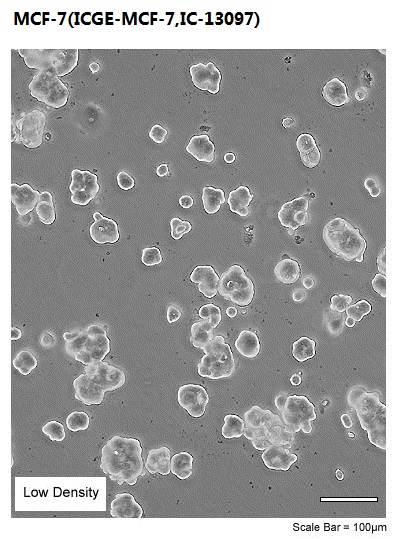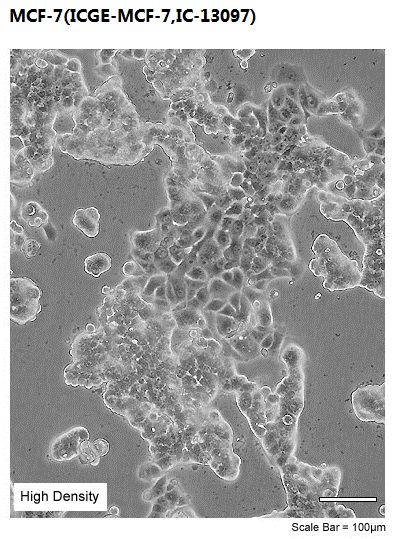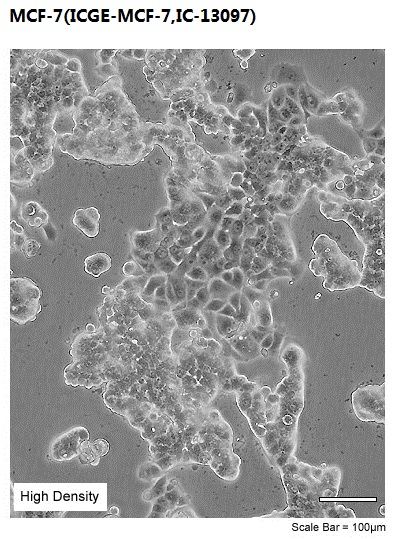


Overview
| Organism | Homo sapiens, human |
|---|---|
| Tissue | mammary gland, breast; derived from metastatic site: pleural effusion |
| Cell Type | epithelial |
| Product Format | frozen |
| Morphology | epithelial |
| Culture Properties | adherent |
| Biosafety Level |
1
Biosafety classification is based on U.S. Public Health Service Guidelines, it is the responsibility of the customer to ensure that their facilities comply with biosafety regulations for their own country. |
| Disease | adenocarcinoma |
| Age | 69 years adult |
| Gender | female |
| Ethnicity | Caucasian |
| Applications |
These cells are suitable as a transfection host.
|
| Storage Conditions | liquid nitrogen vapor phase |
Properties
| Karyotype |
modal number = 82; range = 66 to 87. The stemline chromosome numbers ranged from hypertriploidy to hypotetraploidy, with the 2S component occurring at 1%. There were 29 to 34 marker chromosomes per S metaphase; 24 to 28 markers occurred in at least 30% of cells, and generally one large submetacentric (M1) and 3 large subtelocentric (M2, M3, and M4) markers were recognizable in over 80% of metaphases. No DM were detected. Chromosome 20 was nullisomic and X was disomic. |
|---|---|
|
|
|
| Antigen Expression | Antigen expression: Blood Type O; Rh+ |
| Receptor Expression | Receptors expression: estrogen receptor, expressed |
| Oncogene | The cells express the WNT7B oncogene. Ref |
| Genes Expressed | insulin-like growth factor binding proteins (IGFBP) BP-2; BP-4; BP-5 |
| Cellular Products |
insulin-like growth factor binding proteins (IGFBP) BP-2; BP-4; BP-5
|
| Comments |
The MCF7 line retains several characteristics of differentiated mammary epithelium including ability to process estradiol via cytoplasmic estrogen receptors and the capability of forming domes. The cells express the WNT7B oncogene.
Growth of MCF7 cells is inhibited by tumor necrosis factor alpha (TNF alpha).
Secretion of IGFBP''''''''s can be modulated by treatment with anti-estrogens.
|
Background
| Complete Growth Medium |
The base medium for this cell line is ATCC-formulated Eagle''''''''s Minimum Essential Medium, Catalog No. 30-2003. To make the complete growth medium, add the following components to the base medium: 0.01 mg/ml human recombinant insulin; fetal bovine serum to a final concentration of 10%. |
|---|---|
| Subculturing |
Volumes used in this protocol are for 75 cm2 flasks; proportionally reduce or increase amount of dissociation medium for culture vessels of other sizes. Corning® T-75 flasks (catalog #430641) are recommended for subculturing this product. Note: if floating cells are present, it is recommended that they be transferred at the first two (2) subcultures as described below. It is not necessary to transfer floating cells for subsequent subcultures.
Subcultivation Ratio: A subcultivation ratio of 1:3 to 1:6 is recommended
Medium Renewal: 2 to 3 times per week
|
| Cryopreservation |
Freeze medium: Complete growth medium supplemented with 5% (v/v) DMSO
Storage temperature: liquid nitrogen vapor phase
|
| Culture Conditions |
Atmosphere: air, 95%; carbon dioxide (CO2), 5%
Temperature: 37��C
|


